The 2023 Color in Film Conference returned with a splash, thanks to the organizational mastery of Ulrich Ruedel and Elza Tantcheva-Burdge who held the seventh annual color conference in the beautiful Film Archiv Austria/Metro Kinokulturhaus in Vienna. For the first time the conference was themed around a fascinating new special topic in Color and underwater cinematography, with a particular focus on scientists and diving pioneers Hans and Lotte Hass, as well as Hans Fricke. The Seventh International Conference on Color in Film was supported by The Colour Group (GB), HTW Berlin and Filmarchiv Austria.
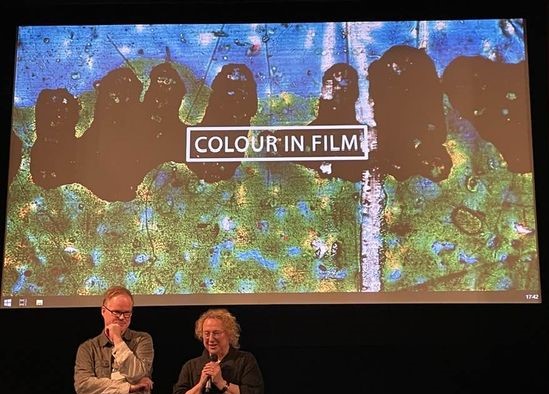
It showcased a treasury of underwater sea delights, from scholarly presentations and curated screenings on magic lantern slides and hand painted, tinted and/or toned fantasy and fairy films to early aquarium and fantasy adventure films, as well as more recent documentaries engaged with the urgencies of climate change and global warming affecting the seas and marine life. The 7th Conference was particularly rich in securing access to visual materials in color cinematography with early underwater films and 2-color subtractive aquarium films. It invited scholars to delve more deeply into the archives of the Austrian Film Archiv, UFA and the EYE’s Desmet Collections (see bibliography at end), and to examine the ways in which color was a key component of different material processes that attempted to represent the underwater world’s kaleidoscopic perceptual array of colored fish, corals, and other marine life on photography, film and projection. We learned about early film pioneers, from the familiar (Zecca, de Chomón, Méliès) who imagined the underwater world as a realm of fairytales and mermaids, to less well-known, like Englishman John E. Williamson (1881-1966), who designed a marvelous octopus device within which a camera operator could sit and film underwater (See Figure 2). Along with the Octopus device, John Ernest Williamson also designed the photosphere (1913) which was a large mobile sphere which seated a camera operator, and which was connected to the surface by a thick tube through which the operator descended by ladder. From Sreya Chatterjee and Ulrich Ruedel, we also heard about the 400 aquarium and underwater films of Ulrich K. T. Schulz. In addition to the aquatic theme, curated screenings included Austria’s first Agfacolor feature color film (Kind Der Donau, 1950), a Heimat Film starring Marika Rökk, and ended with a selection of sponsored and theatrical animated Holiday films, a perfect complement to the sparkling, light-festooned streets of Vienna at Christmas time.

The conference began with two keynotes that gave an overview to the visual representation of the underwater world through phenomenological aesthetics (Dr Franziska Heller) and the inferential color photography and projection that Gabriel Lippmann helped develop (Dr Hanin Hannouch). Hannouch’s talk on the Lippman process examined an unusual series of projected color photographs renowned for their sharp resolution, but which could not be printed or copied, while Franziska Heller’s presentation drew upon some of her earlier work on this material (see bibliography below), and invited scholars to consider these questions:
- How do underwater spaces become a sensual underwater experience?
- What are the technological dimensions of camera, color, and cinematography in depicting these spaces?
- How do many underwater films exemplify pioneer narratives (largely male, adventurer narratives)?
- What are the gendered associations of the human being as spectacle,
- What is the ecology of the underwater film and how is it related to post-colonial narratives?
- How is the underwater world anthropocentric (or not) in its depiction of human and animal/marine life?
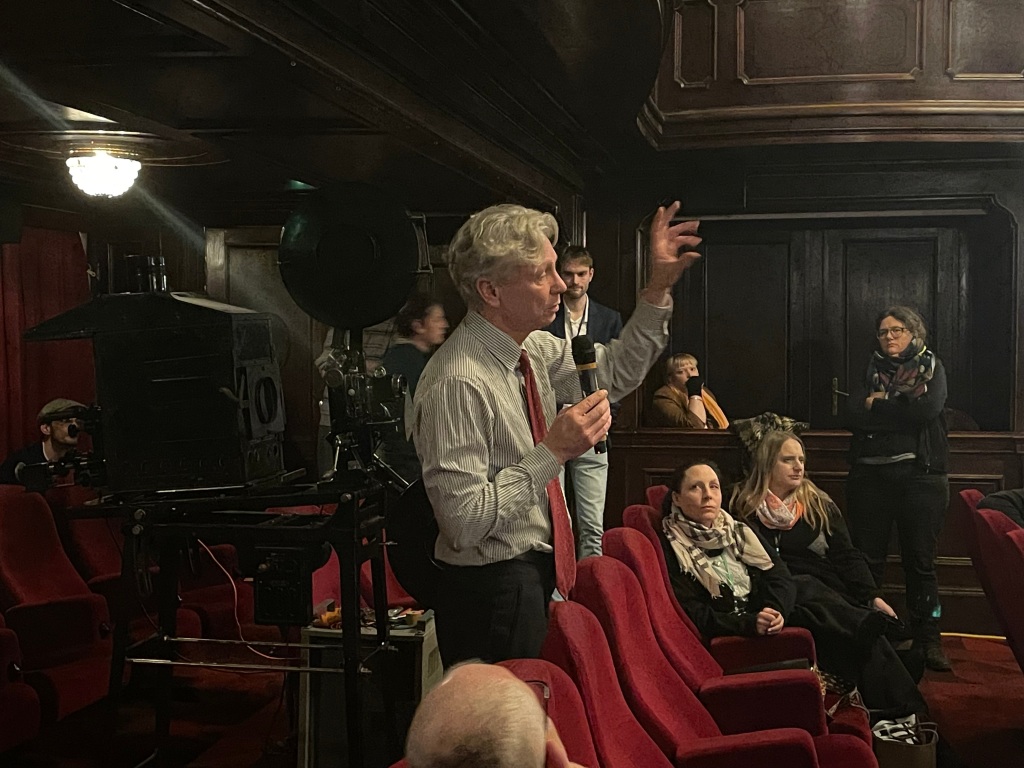
The second day of the color conference included the delightful, slightly terrifying demonstration by Nikolaus Wostry of Kinokulturhaus of a carbon arc Ernemann Imperator projector (1913) (but with acetate rather than nitrate and with a twenties lens). The “ tsss” sound that started the projector reminds you of how flammable and dangerous these devices were. If it caught fire the gas emitted would burn your lungs, produce toxic fumes and kill rapidly. The second day was further complemented by a keynote on color display and perception of flowers and fish from Casper van den Kooi and was followed by an outstanding presentation from Isabel Krek on the aesthetic and technical properties of film projection carbon arc lamps in the 1920s, a rich and relatively untapped new area of research that informs color. Lutz Garmsen also gave a demonstration of the Scan2Screen scanner, software, and workflow.

Field Trip! Conference Attendees had a fascinating behind the scenes visit to the Natural History Museum and Hans Hass Archives, viewing many photographs and other written and visual materials from the Hass archives (see Figure 4). We also viewed some of the many Natural History collection artifacts not on display, including the more than 60,000 skulls in the collection (many of which are prehistoric) held in a vast room-size cabinet and heard about the museum’s recent agreements to return remains to Maori peoples of Aotearoa/New Zealand and Aboriginal tribes in Australia, as well as elsewhere. We later visited the Hans Hass hall at the natural history museum, inside a stunningly beautiful building that with its twin, the KunstHistorisches Museum, mirror each other on Maria-Theresien Platz.
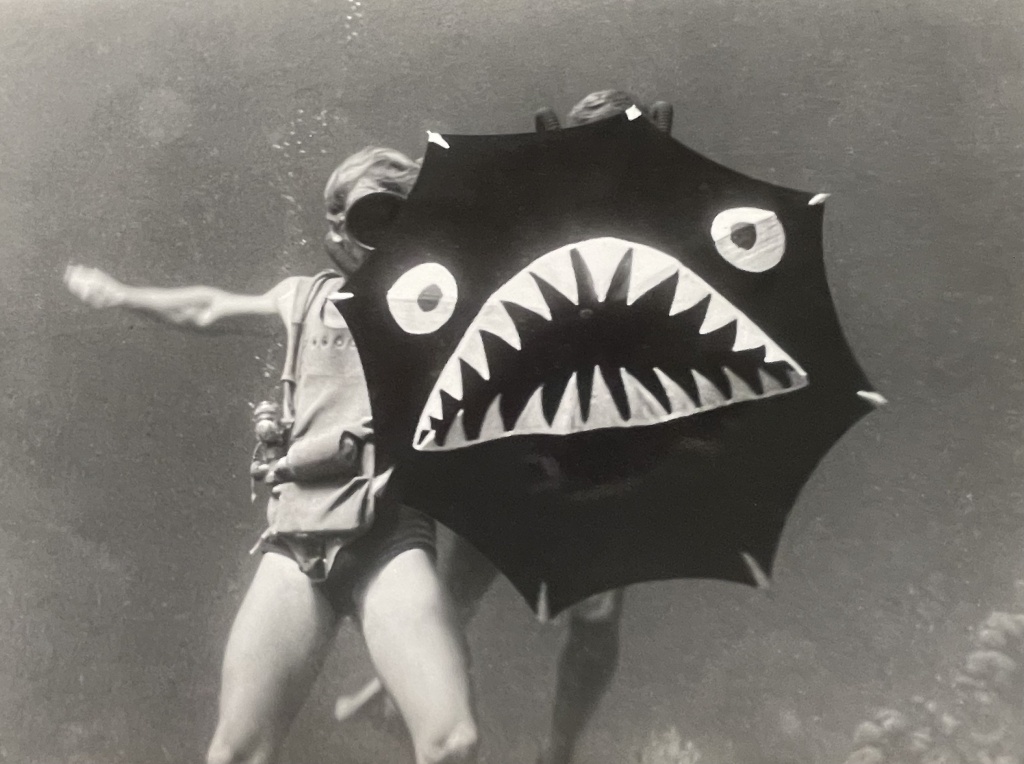
(Hans Hass Archive, Natural Historical Museum, Vienna)
Following a screening of Hans Hass’ Unternehmen Xarifa (Under the Caribbean, 1954), Michael Jung’s research on Hass’ film and underwater techniques was presented by Ulrich Ruedel. It offered a detailed overview of the production and cinematography, including his underwater camera design, while also situating Hass’ work within the adventure film genres first created in the teens and twenties (see Figure 6), beginning with 20,000 Thousand Leagues Under the Sea (Stuart Paton with J.E. & George Williamson, 1915) and further popularized by J .E. Williamson’s media showmanship and films like Terrors of the Deep (1914) and Under the Sea, 1929. This adventure film genre only intensified by the forties and fifties with titles like Beneath the Twelve Mile Reef (Robert D. Webb, 1953), and Disney’s remake of 20,000 Leagues Under the Sea (Richard Fleischer, 1954) with Kirk Douglas and James Mason. Because fear of sharks was very pronounced in the early years of underwater cinematography, Hass and his partners used umbrellas with faces painted on them to scare the sharks when opening them. They discovered it didn’t work ….but that sharks were not to be feared! (see Figure 5).
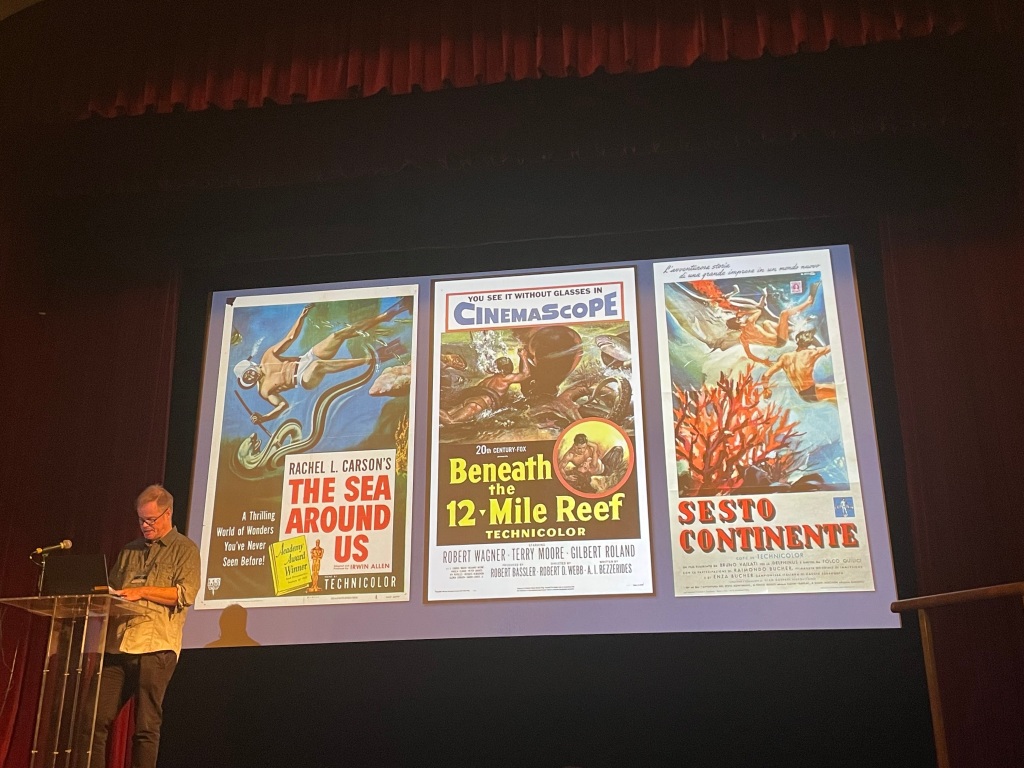
Another special guest of the conference was zoologist and diver Hans Fricke who was inspired by Hans Hass, and who had his own storied career underwater. He once lived two weeks underwater in a house he specially built and was the first to film the Coelacanth, a prehistoric fish which had never been seen alive, given it lived at depth and in darkness. We were honored to meet him and to see exhibitions devoted to the coelacanth where Fricke is also honored in the Hans Hass hall at the Natural History Museum (see Figure 7), while his son Sebastian gave an animated presentation of highlights from his father’s diving and filmmaking career.

This year’s conference theme was a fascinating and rich way to organize screenings and talks around color, and opens up new interdisciplinary directions in which color studies can contribute to the blue humanities, Pacific and Caribbean studies, science film, settler cinema and visual culture, as well as to transnational studies that connect figures like Hans and Lotte Hass, Hans Fricke, JE Williamson and other exemplars of German, Dutch, American and Austrian documentary or adventure cinema. I hope that a number of color scholars will further develop some of the research pathways that were introduced this year. Next year’s conference will return to London. Stay tuned for dates !
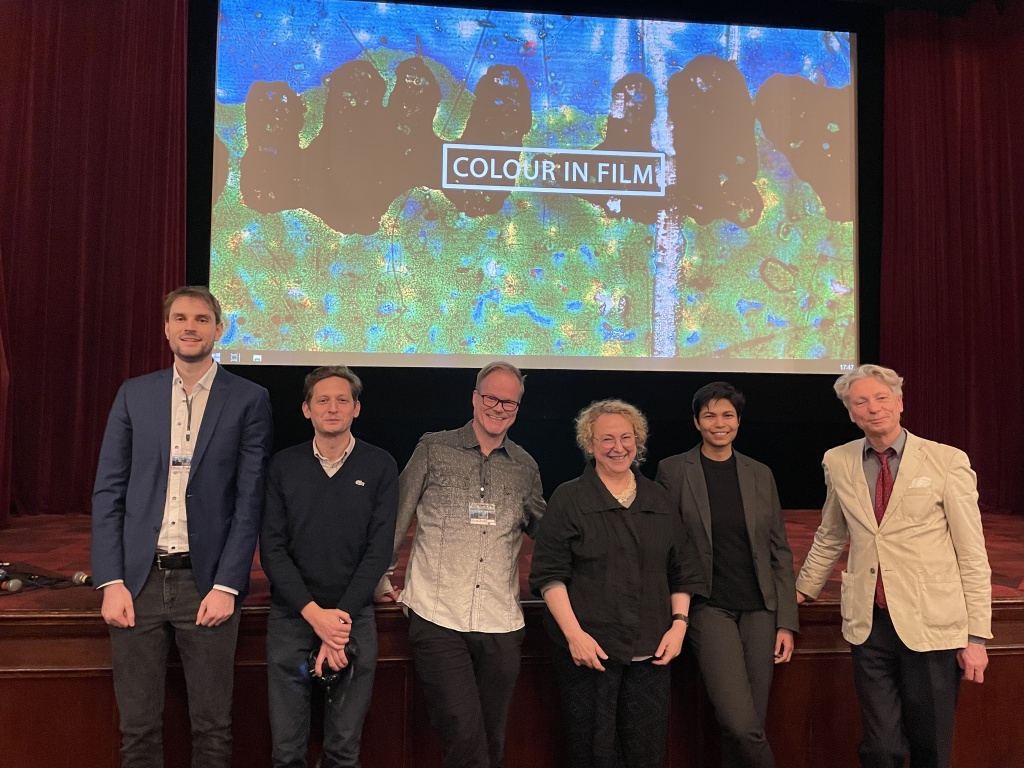
Further Readings and Other Media Links:
- Ann Elias’s Coral Empire: Underwater Oceans, Colonial Tropics, Visual Modernity (Duke University Press, 2019)
- Audio interview with Hans Hess on ARD “Die märchenhaften Farben des Meeresgrundes”
- ( 1953) podcast can be heard here
- Franziska Heller Filmästhetik des Fluiden (Brill, 2010) https://brill.com/display/title/48542?language=en
- Franziska Heller “Water and film: fluidity of time and space and its somatic perception” WIREs Water. 5 (6) November/December 2018 https://wires.onlinelibrary.wiley.com/doi/abs/10.1002/wat2.1315
- EYE Collection https://www.eyefilm.nl/en/collection/collections
- Filmarchiv Austria https://www.filmarchiv.at/en/sammlung/
- Deutsche Kinemathek https://www.deutsche-kinemathek.de/en/visit/exhibitions/ufa-history-brand
- Federal Archives (Film) https://digitaler-lesesaal.bundesarchiv.de/
- Aquarium films examples can be seen here
Bio notes: Kirsten Moana Thompson is Professor of Film and Media and Director of the Film and Media Program at Seattle University. She teaches and writes on animation and color studies, as well as Pacific, and American studies. Recent work has focused on the animated ‘useful’ film; intersectional animated surfaces in Moana; the material color history of Disney 2D animation and the ink and paint department, and Ludwig von Drake and the Disney promotional film. She is the author of the award-winning Animation and Advertising (co-ed. M. Cook, Palgrave, 2019), the first book to examine the relationship of animation with non-theatrical media. She has also published Apocalyptic Dread: American Cinema at the Turn of the Millennium (SUNY Press, 2007); Crime Films: Investigating the Scene (Wallflower: 2007), and coedited with Terri Ginsberg Perspectives on German Cinema (GK Hall: NY, 1996). Other recent work includes “Tattooed Light and Embodied Design: Animated Surfaces in Moana” eds. Paula Massood et al in Media Crossroads: Intersections of Space and Identity in Screen Cultures (Duke UP, 2021), as well as essays on Aggie Grey and Tourism; the material color history of Disney and Faber Birren; Ludwig Von Drake and the Disney promotional film, and the animated advertising spokescharacter Reddy Kilowatt. She is currently working on three new books, Color, American Animation and Visual Culture, 1890-1960; Bubbles; and Animated America: Intermedial Promotion, from Times Square to Walt Disney.
Pingback: Colour in Film